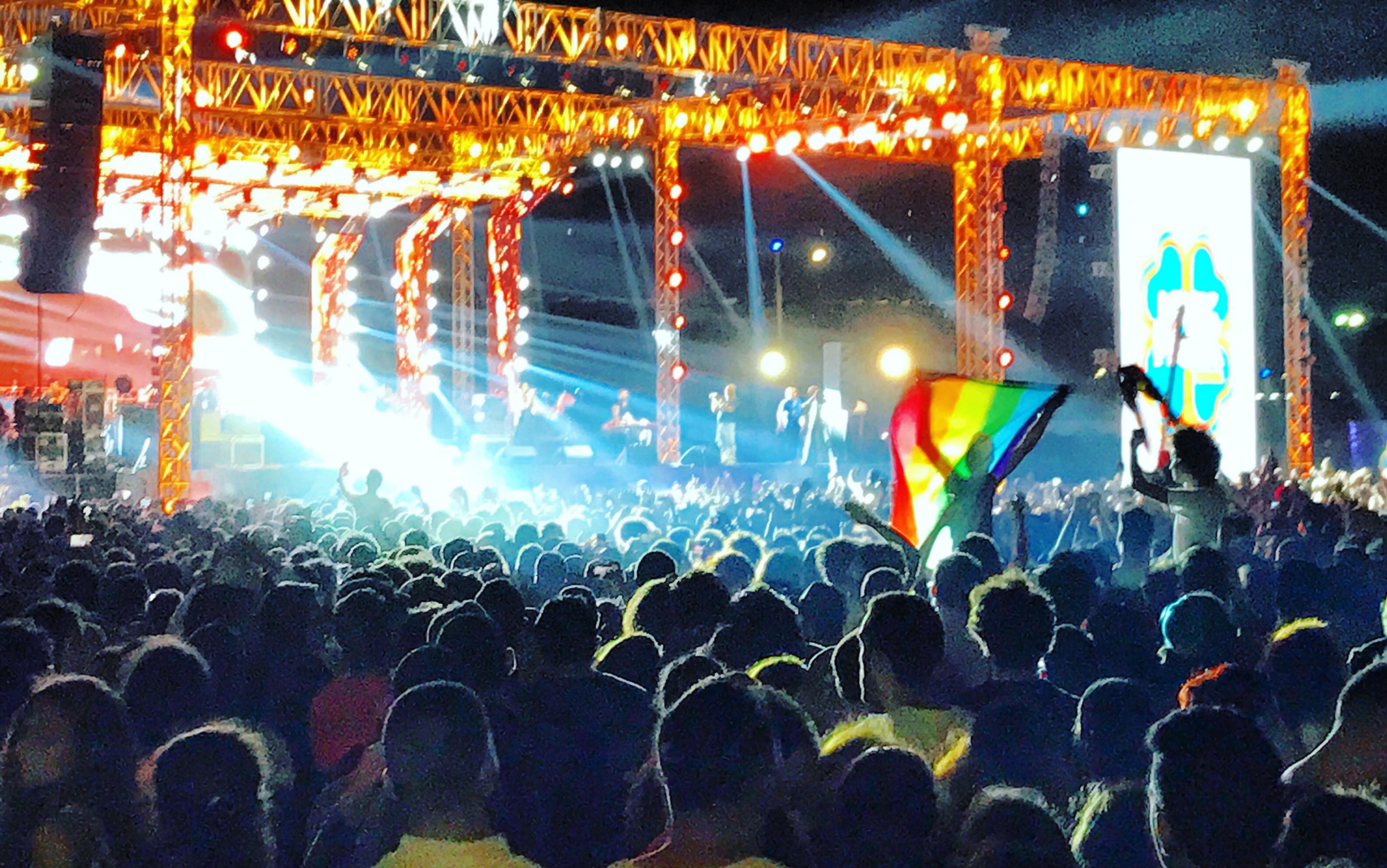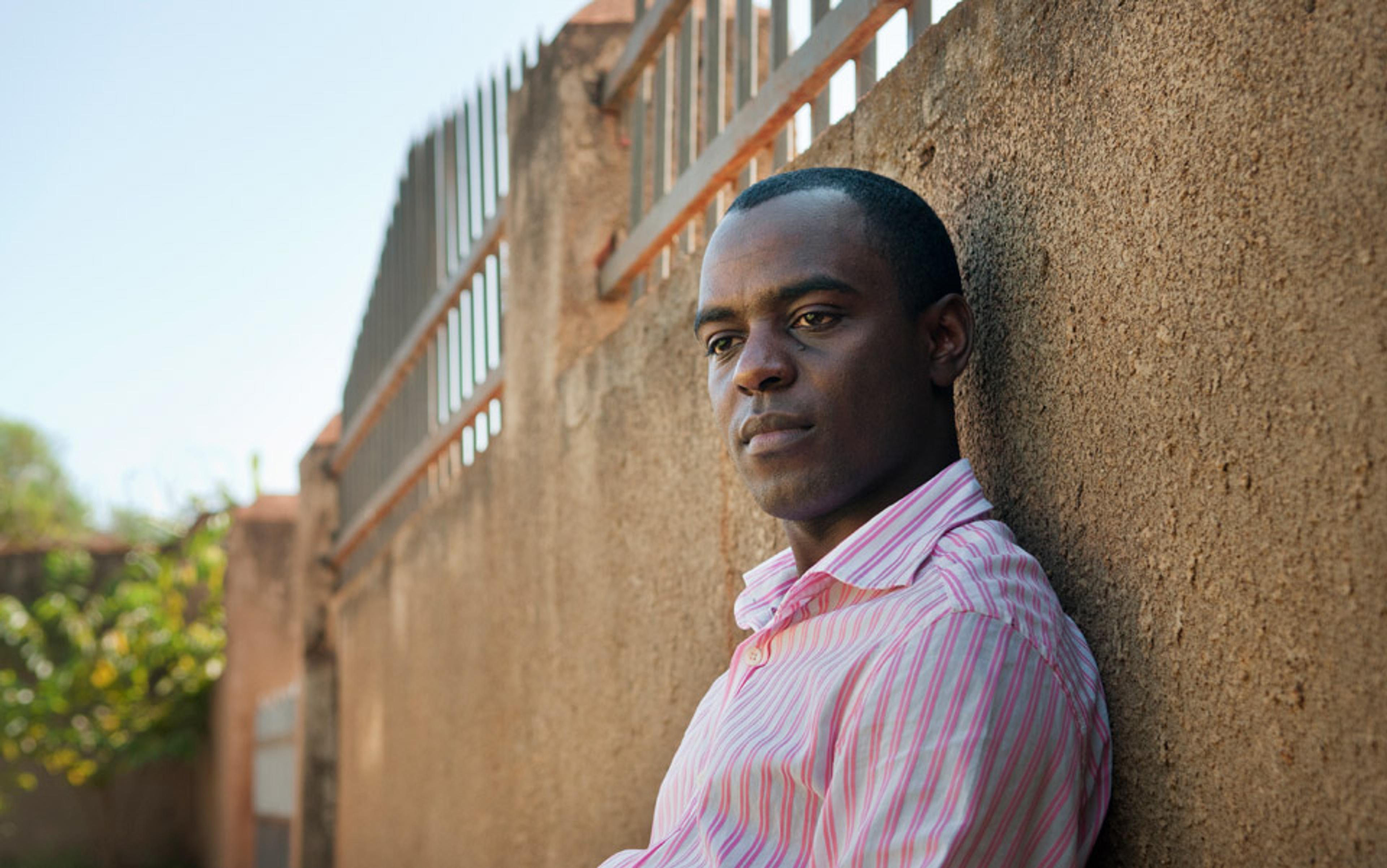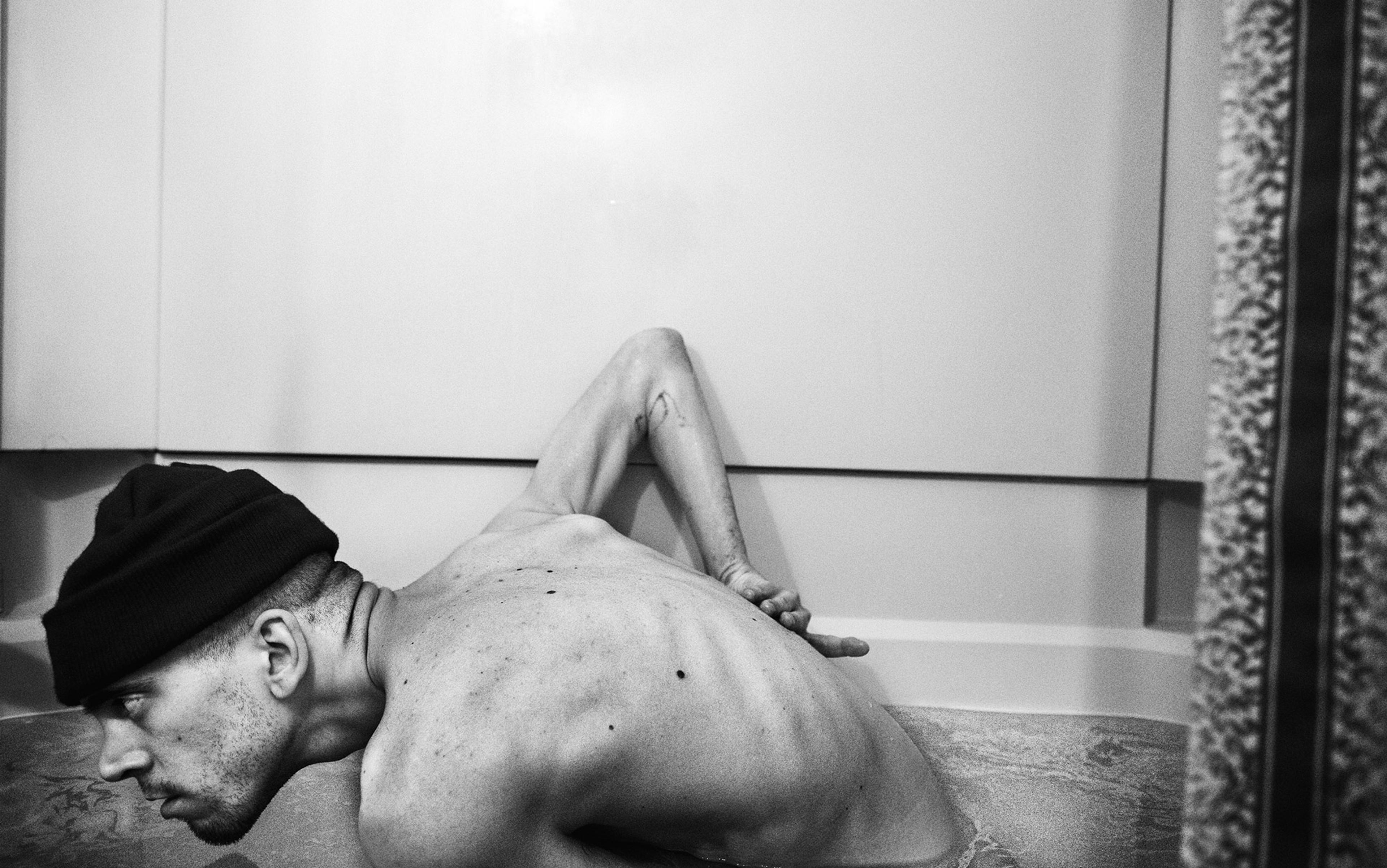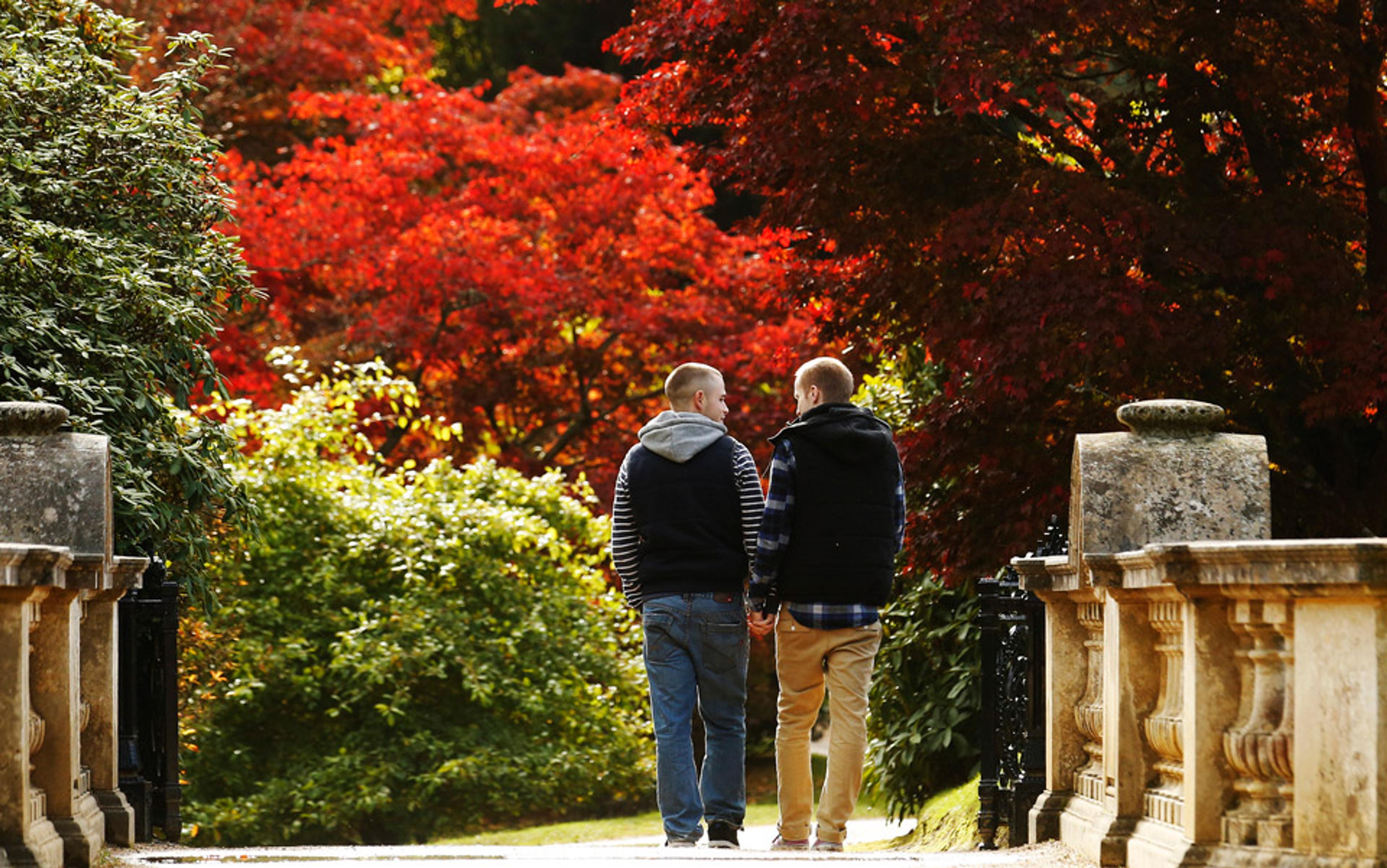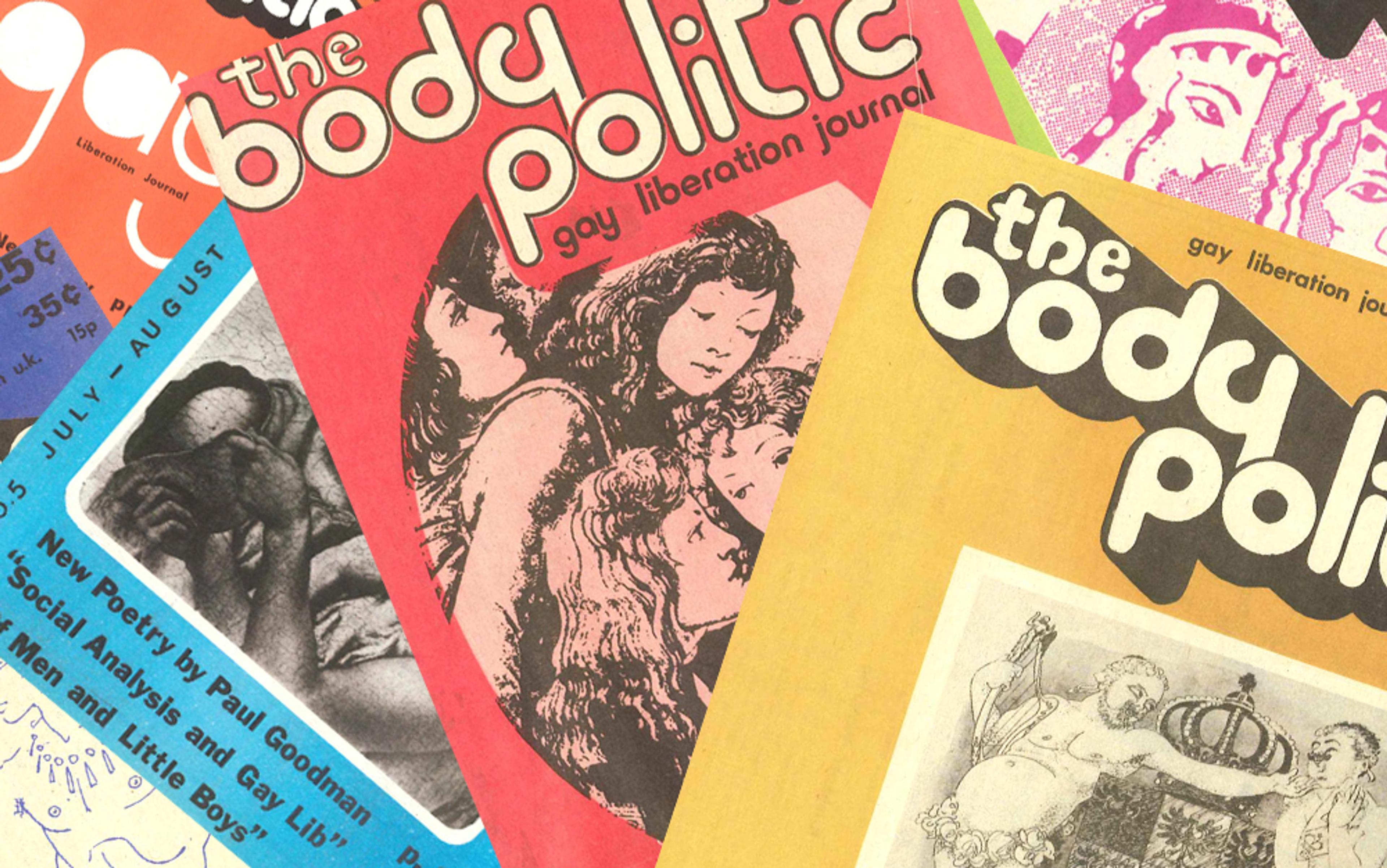‘Salt Lake is a very queer place,’ said the historian J Seth Anderson after he and his husband became the first gay couple to be married in Utah, in 2013. When most non-Utahns think of the state, probably the last thing that comes to mind is ‘gay’. Instead, they might think of the Church of Jesus Christ of Latter-Day Saints (LDS, aka Mormons), whose members constitute 42 per cent of the population. Or maybe they think of Republicans, who outnumber Democrats nearly four to one.
While counterintuitive, Anderson’s statement about Salt Lake City’s queerness is true in most senses of the word. First, Utah defies norms and boundaries. For many who study queer theory, queerness isn’t just about who you love or your sexual identity. It’s also a lens for understanding how society defines what’s considered normal or different, and how these definitions affect different behaviours and groups of people. In that sense, Utah can be seen as queer because it defies or ‘queers’ normative culture in the United States. Second, Salt Lake is simply home to a lot of queer people. In fact, the city has the 13th-highest rate of LGBTI-identifying residents of all US metropolitan areas.
With this in mind, what is it like to be gay in Salt Lake today? In late 2020, I found myself in a conversation at a (primarily LGBTQI+) party in Salt Lake when the question was raised: ‘How many of you served a Church mission or were serious Church members?’ Everyone except me (a never-Mormon Utah native) raised their hand… and then nervously laughed at how much the Mormon Church had shaped their lives. Serving a mission in the LDS Church is a particularly intense commitment, usually requiring 18-24 months of continuous service in a designated location – often far from home – and a substantial reduction in contact with friends and family during that time. And many of the queer people in that conversation with me had dedicated years of their lives to these missions, regularly going to church, attending the Church’s flagship Brigham Young University, and living among communities brought together through affiliation with the Mormons. Even though everyone at the party had since left and often fiercely disavowed the LDS Church, I wondered to myself how much it was still shaping their lives in the present day.
I am a queer Utahn and, even though I was never a member, the LDS Church has significantly influenced my worldview. I grew up in a community where Mormonism was the norm (my home county is 83 per cent LDS, according to the most recent statistics), so Mormonism and my relationship to the faith shaped my understanding of what’s ‘normative’ – the standards or rules considered typical, acceptable or ideal. These standards dictate what behaviours, beliefs and values are seen as ‘normal’ or desirable, and often influence how individuals are expected to think and act. It was only in my mid-20s, when I entered my first serious queer relationship, that I looked back to my time in Utah and immediately recognised the familiar, frustrating feeling that comes with questioning the socially constructed boundaries that determine what is normal vs what is ‘deviant’.
Thinking far beyond my personal experience, the coexistence of Mormonism, conservative politics and queerness in Utah presents many contradictions. On the one hand, queerness weighs heavily in certain readings of LDS Church history due to the since-rejected doctrine of polygamy. In the 19th-century US, polygamy was deemed a sexual deviancy, which forced the Mormons to flee west, out of the Union, to Utah, in order to protect their sexual preferences. Yet some view contemporary, conservative LDS Church policies as deeply homophobic, and Mormons are increasingly identifying with Trumpism (despite important exceptions, which I will detail below).
Herein lies the fascinating paradox: Utah’s queerness isn’t merely about its LGBTQI+ population. Rather, it embodies a deeper, more fundamental queerness rooted in the very fabric of the state’s history, particularly its origins in Mormonism. From its early days of polygamy and unique religious practices, Mormonism has always defied conventional norms. Despite many Utahns’ usually conservative stance towards LGBTQI+ matters, an intrinsic oddity permeates Utah’s culture, creating an environment where queerness, in the broadest sense, can thrive while simultaneously being suppressed or disavowed.
By the norms of Republican states in 2016, Utah was acting queerly, once again
So, how does queerness shape Utah for gay and straight people, and for Mormons and non-Mormons alike?
Walking the streets of Salt Lake City, queerness, Mormonism and conservative politics are visible both in political discourse and in the urban landscape. The city has become something of a theatre where these contradictions play out symbolically. Planned entirely around the LDS Temple, contemporary Salt Lake is marked by religious and political symbolism that can, at times, feel contradictory. When I returned to Utah during the election season in 2020, I was especially struck by the symbolic politics of flags: pride flags flew next to MAGA flags, both flying next to LDS infrastructure throughout the city and state. With Donald Trump’s lead in Utah only widening in 2024, this pattern is emerging once again.
Trump flags that proclaim the wish to make America great again might seem unsurprising given that Utah is consistently a majority Republican state, but this is actually a big change since 2016. Back then, many Mormon Republican Utahns had followed the lead of Utah’s senator Mitt Romney and the then-governor Gary Herbert (both LDS Church members) in rejecting Trump’s politics, turning away from their party’s candidate at an unheard-of scale. In March 2016, only 14 per cent of Utah Republicans polled for Trump. By October that year, Evan McMullin, a Utahn running as an independent against Trump, was poised to win key districts. By the norms of Republican states in 2016, Utah was acting queerly, once again. For many analysts at the time, this was due to Utah’s unique political culture, dominated by the Mormon Church.
But as political scientists have argued, so-called political cultures – like cultures more generally – should not be understood as deep-seated or fixed psychological traits. Instead, they’re shaped by symbols, practices and histories that can change or be reinterpreted depending on the situation. Identifying key components of the practices and histories that compose Utah’s politics includes not only an analysis of the symbols and histories of Mormonism but also the symbols and histories of Utah’s multifaceted queerness itself.
Polygamy was introduced in 1843 by Joseph Smith, the founder of Mormonism, as a doctrine called ‘plural marriage’. Smith claimed to have received a revelation from God endorsing the practice, and it became a distinctive aspect of Mormon theology and culture, not to mention a radical and controversial departure from the societal norms of the time.
The US government, seeking to combat the perceived threat of Mormonism to the reigning social order, passed antipolygamy laws, leading to decades of legal and social conflict. If the Mormons continued to practise polygamy, Utah – then called the state of Deseret – would not be permitted to join the Union. In 1890, under the leadership of Wilford Woodruff, the LDS Church officially renounced polygamy and complied with other federal requirements, as a condition for Utah’s statehood. (In 2015, some of the old arguments reappeared in debates about same-sex marriage, when opponents of gay marriage used those ‘natural law’ arguments against Mormon polygamy in Obergefell v Hodges; ultimately, the case legalised same-sex marriage across the US.)
In his book Make Yourselves Gods (2019), the scholar Peter Coviello analyses Mormon history and theology through a queer theoretical lens. He points to Louisa Beaman, one of Joseph Smith’s wives. Secretly married to him in 1841, she attended her wedding in Nauvoo, Illinois disguised as a man, ostensibly to avoid the illegal marriage being detected. The moment can be read as poignantly queer, running in sharp contrast to the Church’s contemporary stance, which values the heteronormative family above almost all else. LDS theology regards the family as a fundamental unit of society not just on earth, but in the afterlife and for eternity. While today’s eternal family is rooted in cis-gendered monogamy between husband and wife, a character like Beaman opens up the possibility of viewing Mormon polygamy as being beyond the purely patriarchal. Instead, it can also be read as a non-normative sexual, marital and familial practice that challenged the sexual norms of the time.
‘Same-sex romantic behaviour’ is listed as grounds for disciplinary action in the BYU honour code
What do we make of the Mormons’ abandonment of the once-central practice of polygamy? The pressure of American secularism, whiteness and norms in the 19th-century US pushed them along. It could be that Mormons overcompensated for their oddness, their queerness, by making the heterosexual family a central focus of their theology. This emphasis is perhaps best embodied by a document that, as a kid in Utah, I saw prominently framed on many of my LDS friends’ walls. Titled ‘The Family: A Proclamation to the World’, it seeks to ‘solemnly proclaim that marriage between a man and a woman is ordained of God and that the family is central to the Creator’s plan for the eternal destiny of His children.’
As one may imagine, given the importance of such a document, the contemporary LDS Church has faced criticism for its stance toward LGBTQI+ individuals and families. The Church has consistently opposed same-sex marriage, actively supporting initiatives against it, and maintaining its doctrinal position that marriage should be between a man and a woman. The implementation of an exclusion policy in 2015, which labelled individuals in same-sex marriages as apostates and restricted certain religious rites for their children, generated significant backlash before being rescinded in 2019. While the Church does acknowledge the existence of same-sex attraction, it teaches that acting on such attraction is inconsistent with its moral standards. BYU also has a harsh policy toward queer students, with ‘same-sex romantic behaviour’ listed as grounds for disciplinary action in their honour code, forcing students and athletes to remain closeted in order to keep their scholarships and receive their diplomas.
Listening to students’ stories over the years, the human impact of these policies becomes all too clear: Mormonism and queer liberation seem completely opposed. Yet, as Coviello shows, the polygamous Mormons of the 19th century were subject to a related pressure to conform; and the state of Utah itself was born from the renunciation of a certain kind of queerness in the public mind.
In 1856, Mormons were sometimes understood as queer because people thought their practices were strange and not ‘white’ enough. Today, they are often seen as outside the norm because of their straight-edge conservative values, which cause them to be ‘othered’ by those with more liberal social and political beliefs. Complicated and contradictory queer histories are reconciled, claimed, disavowed, ignored and recalibrated in light of contemporary politics of identity and sexuality in Utah. Queerness is a kaleidoscope, ever visible in the public space through things like flags, viral social media and electoral politics. If Utah was acting queerly in 2016 in its refusal to support Trump over other Republicans, by 2020 most of the state had leaned into the mainstream Republican agenda. Romney was literally heckled on stage at the Utah Republican Convention in 2021 because of his opposition to Trump, and MAGA flags became prominent in front yards and on pick-up trucks.
Amid the maelstrom, another flag has popped up everywhere in Utah – the rainbow flag. Since 2020, the LGBTQI+ pride flag seems to appear more prominently in Salt Lake City’s windows, yards, porches and flag poles than in any ‘gay-friendly’ city I’ve lived in since I left Utah aged 18. The flag’s prominence is hard to overstate – walking the streets with my non-Utahn fiancée over the past few years, we have repeatedly noted that the rainbow is more common in Salt Lake than in the liberal places we frequent, like Chicago, Ann Arbor, Paris, Denver or New York. In Salt Lake cafés in early 2024, I heard murmurs of excitement about Pride Month far more often than I did in other cities, where many queer people have become exasperated with rainbow capitalism or the commodification of queer symbolism for corporate profitability.
At first glance, Salt Lake’s pride flag phenomenon might suggest nothing more than an aloofness to the flaws of corporate pride, the changing tides in the political landscape of the city, or maybe even an influx of LGBTQI+-identifying people moving there. While these arguments are not without merit, careful observation leads me to note that the pride flag doesn’t always directly correlate with LGBTQI+ identification or even allyship, but seems to have other, less obvious meanings that allude to the complex relationship between Mormonism, queerness and the question of Utah’s statehood.
Attention to how and when people choose to display these symbols leads me to believe that rainbow flags in Utah represent a broad statement of ideological juxtaposition in something of a ‘flag-flying contest’. On the one hand, the pride flag is a disidentification with Trump politics: ‘I’m not with them,’ it seems to say. To name one illustrative example, as I work on this essay on the porch of a downtown café, I see two people on the sidewalk in front of me. One points to a flag flying above the café, and says: ‘Seeee? Pride flag!’ The other gives a nod of approval, and they turn to enter the shop, doubts assuaged. In a place of what might be called ideological extremes, pride flags don’t just symbolise rainbow capitalism but a broader sense of safety and ideological identification.
Connectivity and community are important to both queer and religious identities
However, Utahns have also pointed out other state-specific nuances of meaning to me: ‘I’m not Mormon…’ or at least ‘I’m not that kind of Mormon.’ For certain progressive Mormons, the pride flag serves as an almost apologetic symbol to set them apart from their Trump-voting fellow Church members – while others see queerness and Mormonism as unavoidably at odds. A former Mormon and lifelong Utahn friend insists that it is this battle that’s really at the heart of Salt Lake’s many rainbows – the argument that Mormonism can be friendly to queerness. I don’t think everyone would agree but, for all parties, gayness seems to have become what the anthropologist Darryl Li calls a competing universalism – an alternative vision for humanity (and Utah) competing with certain iterations of Mormonism, conservatism, liberalism and US identity.
By some arguments, such a broad definition of queerness can empty the term of its meaning and raise serious questions: can patriarchy be queer? Can queerness stem from a starting point of homophobia? Can it be rooted in conservative – rather than progressive – values? If so, does queerness mean anything beyond just ‘deviance’? At the same time, considering Utah as queer allows us to explore the many aspects that make up the concept. This in turn productively challenges certain binaries – such as the assumed oppositions between queerness and religion – in the process. As the legal scholar Jeffrey A Redding has argued, connectivity and community are important to both queer and religious identities, suggesting that there are often missed opportunities for alliances based on shared visions.
Utahns explain the impulse to call on a queer vision for their state in several ways. First, the advent of the internet and then later social media have put the Church’s policies and peculiar history under a type of scrutiny unparalleled since Mormonism’s early years. Consequently, the Church has issued veiled advisories cautioning against certain online spaces, such as the infamous ‘exmormon’ reddit where doubts about LDS history and doctrine are discussed in at times colourful terms.
More recently, the Black Menaces – a group of Black BYU students who went viral on TikTok and even won The Salt Lake Tribune’s 2023 award for Utahn of the Year – strive to ‘empower marginalised communities through social media’, within the context of BYU, a bastion of Mormon conservative ideals. In one of their TikToks, conducted as an on-campus journalistic report, the Black Menaces ask fellow students a simple question: ‘Do you support gay marriage?’ The viral video has had more than 20 million views, and features responses ranging from (very) awkward ‘No’s to affirmations of the queer community, highlighting the diversity of opinion at BYU.
It’s interesting to ponder why the Black Menaces pinned a video about queerness to the very top of their TikTok page when the primary focus of their cause is racial discrimination at BYU. The most obvious explanation (and the way the Black Menaces might explain it themselves) is the value of intersectionality, or the understanding that individuals’ identities and experiences are shaped by the intersection of multiple social factors, such as race, gender, class, sexuality and ability, which interact to produce unique forms of privilege and oppression.
One factor to be considered in this intersectional approach is Utah’s very queerness. To be more specific, the Black Menaces’ politics, queerness and queer iconography play a central role in their effort to build an alternative vision for Utah and BYU that is, in their words, ‘not built on “othering”.’ Rainbow iconography symbolically draws together the liberation of intersectional marginalised communities, specifically in the queer way that Utah represents. Queerness may be front of mind for the Black Menaces, not just because they are good at understanding intersectionality, but also because queerness speaks to Utah’s history and politics more than other frameworks. Queer theory, queer critique and conversations about being queer can build a sense of solidarity between Mormons, including the Church itself, and the oppressed and marginalised communities of Utah and BYU.
In the period since Trump’s 2020 defeat and the rise of the Black Menaces, official LDS messaging and membership have started to look different. The LDS Church, recently revealed to be in sharp decline in Utah, has responded to this rainbow-coloured competing universalism through an ambiguous reembrace of certain kinds of queerness. In 2022, the Church backed legislation to support same-sex marriage, and there has been a noted quieting of anti-gay rhetoric among leaders, even as anti-trans and anti-gay legislation are on the rise across the nation. Rumours, such as the one circulated in a viral TikTok in 2023, allege that the Church is going to change its official stance on same-sex marriage by 2025, citing the precedent of the 1978 Revelation on the Priesthood, which reversed the Church’s ordination ban on Black members.
Bird asserts that ‘being gay and religious cannot become an oxymoron’
Also cited is the rise to fame of Charlie Bird, the former BYU-mascot-turned-influencer and devout gay Mormon. Rather than flying the pride flag in opposition to Mormon symbolism, Bird puts these sets of symbolic practices back into dialogue. The Church seems to be cautiously responding: posted from the official account of the LDS temple in Washington, DC, in response to one of Bird’s photos in front of the temple with his fiancé, the comment said: ‘This is beautiful. Thank you for sharing your experience and touching testimony.’ While a mere Instagram comment may not seem significant, for many Mormons, likely including Bird, an official response to a queer Mormon marriage is symbolically enormous.
For many queer individuals, including myself and many Utahns, Bird’s steadfast loyalty to the Church, despite its history of homophobia, can be both frustrating and contradictory. In his books and op-eds in the LDS-owned Deseret News, Bird asserts that ‘being gay and religious cannot become an oxymoron.’ Yet he also emphasises: ‘I want to be very clear: I’m not advocating for structural or doctrinal changes, nor seeking for anyone to criticise or condemn my faith.’
Such a stance often elicits frustration, making some queer people (me, usually) want to shake him and ask: ‘What are you doing? Free yourself from this impossible balancing act!’ It’s easy to diagnose Bird as deeply in denial – potentially even as a masochist in his commitment to an institution that discriminates against him – but can he see something we don’t, a possible future that the ever-deepening divisions of US politics have obscured?
Viewing Utah through a broader lens of queerness prompts me to reconsider my judgment of Bird’s persistence in reimagining his religion. While Bird brings the symbolic politics of normative Mormonism into dialogue with queer sexuality, the politics of Mormon, Trumpist and queer identities in Utah represents a distinct iteration of a phenomenon unique to the state. The Mormon Church’s pivot to Trumpist politics and homophobia (along with Utah’s potential rejection of Trumpism and homophobia), much like their 19th-century transition from rebellious polygamy to monogamy, was a negotiation and a battle for Utah’s ‘queerness’ in all senses of the word.
The abundance of pride flags in Salt Lake City – and the politics they represent – reveal more than queer allyship and queer presence. They are evidence of the way queerness and Mormonism define what it means to be from the state of Utah. Thinking of Utah in this way, I hope, might address conflicts and open potential areas of collaboration between religious and queer communities – alliances that seem full of potential as the US faces an all-too-familiar polarising election this year.

